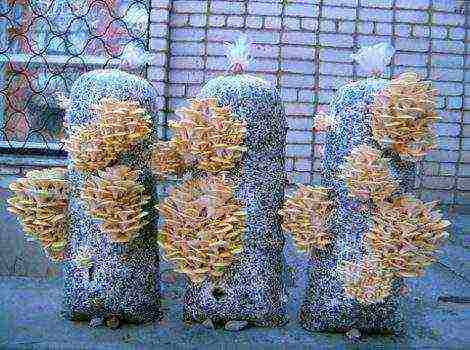Content
In the human diet, a product such as fish must be present. You can buy it in any store or market, but you can also grow it yourself: of all freshwater fish species, the most profitable for breeding is a relative of the wild river carp - carp... It is about how to breed this fish in a personal plot in small ponds or pools that will be discussed in this article.
Advantages and disadvantages of carp breeding
Growing carp on your own has both advantages and disadvantages.
Advantages:
- Fast growth - unlike other representatives of its family, this cultivated species grows very quickly, reaching by the end of the first year its weight up to 400-500 grams. At the end of the second year, the fish is able to reach a marketable weight of 1 kg.
- Unpretentiousness - carp are not as whimsical to the oxygen content in water as most river freshwater fish.
- High quality meat - in this fish, it is soft, tasty and has a relatively small amount of small bones.
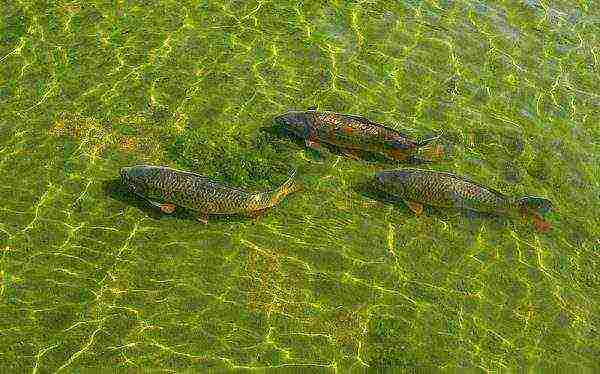 Carp is fast growing
Carp is fast growing
Flaws:
- Frequent morbidity fish with a very dense population of their capacity
- Initial costs for the purchase of fry and the device of the pool are high enough
Breeding technology at home
Purchase of fry
You should only buy fry in specialized fish farms have a good reputation and have been working for a long time.
Fish seed should not be purchased from unverified and unreliable suppliers - private individuals engaged in carp breeding and reproduction, newly formed fish farms.
It is better to transport purchased fry in spacious buckets or fishing canals. It is better to take water from a pond or lake, in extreme cases - rain.
Organization of food - what and how to feed
 If carps receive a balanced and nutritious diet, then in 9 months it is quite possible to grow a half-kilogram fish
If carps receive a balanced and nutritious diet, then in 9 months it is quite possible to grow a half-kilogram fish
A neglected carp should be fed twice a day:
- Early in the morning - when the sun has risen and the water has warmed up enough
- In the evening, before the sun goes down
It is better to use as feed:
- Finely chopped rain worms
- Fodder bloodworms
- Larva caddis flies (shitika)
- Steamed cereals - oats, wheat, barley
- Bread rye
In order for the pool to also contain all kinds of bottom microorganisms, small crustaceans that carp feed on, it is necessary to periodically add water from a nearby pond or lake. You should also periodically feed the fish with special compound feed.
In order to periodically catch the largest specimens fish should be fed in the same place, by making a small tray in it into which the food will be poured
The food should be filled in in small portions so that it is completely consumed by the fish and does not fall to the bottom of the container, rotting there over time and causing a deterioration in water quality.
Launching fish into the pool
The purchased fry should be launched either in the spring or in the fall.
Spring stocking is preferable - the fish has time to gain weight before wintering and adapt to habitat conditions
It is necessary to launch the fry in the spring when the water warmed up to a temperature of 22-25 ° C.
Conditions of keeping and growing
Pool, location and dimensions
You can either buy a ready-made plastic pool or fill it yourself.
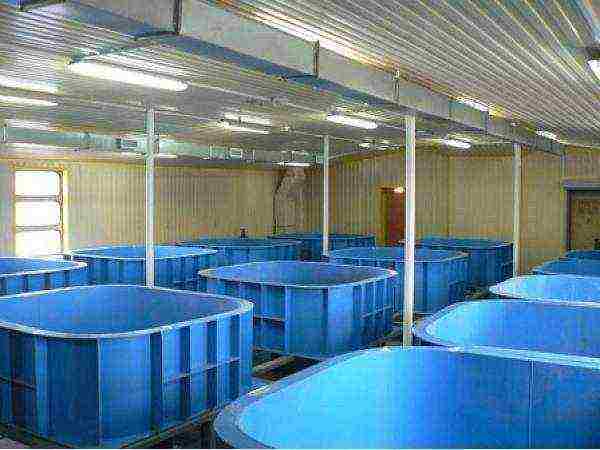 Pools for fish farming made of polypropylene
Pools for fish farming made of polypropylene
The most convenient for growing carp in a personal plot or summer cottage is a round container made of plastic or polypropylene with a diameter of 2 to 3 meters and a depth of at least 1.2-1.5 meters.
It is better to position the container in such a way that part of it is illuminated by the sun for most of the day in summer, and the other is in the shade. This arrangement will help to avoid overheating of the water and will allow the fish to take refuge in the cool shade in the heat.
Also, pools can be located in frame greenhouses or garages.
Water quality
The pool water must be renewed. For this, the following system is mounted:
- Filter with pump taking water from a nearby stream or small river
- Polyethylene pipe line connected to the pump and supplying water to the tank
- Drain line from a polyethylene pipe of a larger diameter than the supply. Place the drain line at the bottom of the tank and lead it into a stream or river, installing a tap or a plug at the end
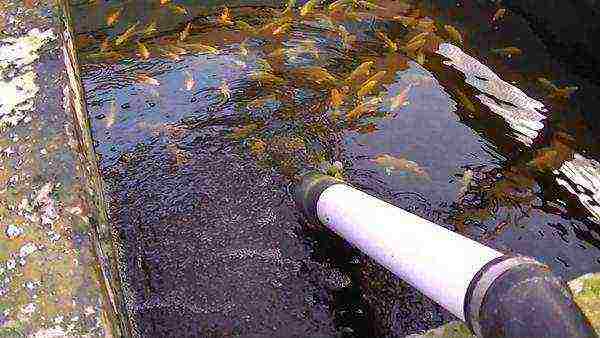 Pool water is regularly updated
Pool water is regularly updated
If there is no river or stream nearby, then it is necessary to use water from the well, pumped into the pool by a submersible pump with a filter. In this case, the water must be drained through a filter into the sewer.
Tap water rich in bleach and minerals should not be used to breed specks.
Temperature
Pool water during the growth and development of fish should warm up to a temperature of at least 22-25 ° C, but not more than 30 0С.
Such a temperature background is achieved by placing the container in a sunny place and periodically replacing (draining) part of the water.
Oxygen content
Although carp is unpretentious to the content of dissolved oxygen in water, it a deficiency can lead to a slowdown in growth or complete death of the entire livestock.
 Water aeration
Water aeration
To increase the oxygen content, special aerators or low power compressors should be used.
Reproduction
Reproduction of carp is a rather painstaking process. To do this, when catching 2-3 year old fish in the fall, leave several large heterosexual individuals in a container so that they spawn in the spring:
- In order for carp to reproduce, it is necessary make two separate spawning and nursery ponds... Spawning should be 3 × 3 meters in size with a depth of no more than 0.5 meters. The nursery pond should be slightly larger in area and depth. Its optimal size is a square with a side length of 4 meters and a depth of up to 1.5 meters.
- In ponds it is necessary provide a fresh water supply system from a river or stream, well, as well as its discharge
- In early spring when the water warms up to 18-20 0С in the spawning pond, you must first transplant 1-2 males during the day, and closer to the evening - 1 female
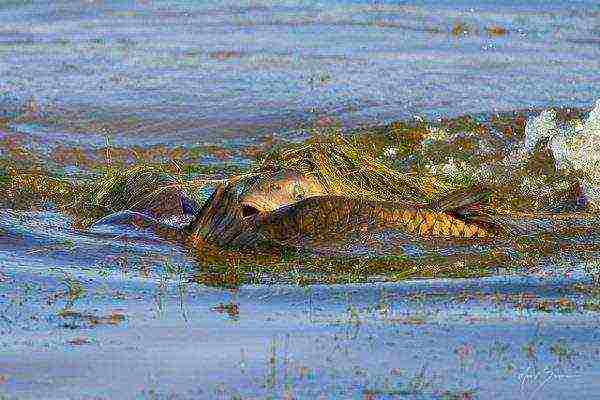 Spawning in carp begins when wheat blooms
Spawning in carp begins when wheat blooms
- In order for the females to have something to lay eggs in the pond in advance, they should plant with reeds or cattails, or place freshly cut meadow sod at the bottom
- After fertilized larvae hatch, large carp must be returned back to the pool
- 6-8 days later the spawning pond should be lowered, and the larvae should be caught with a fine-mesh net and transplanted into the nursery pond
- In the nursery pond larvae should be fed with small bloodworms, special compound feed, milk powder
- The nursery pond must be lowered before winter., and grown fry weighing 15-20 grams. transplant into a pool or large home aquarium
What to do with carp in the pond in winter
- In winter, in a dug-in or solid-cast concrete pool carp can overwinter provided the fact that the container does not freeze to the bottom and a sufficient amount of oxygen will get into it
- In order for the container not to freeze after it has formed a sufficiently strong ice cover for walking, it is necessary cover with a large layer of snow, in the absence of such - with insulation mats and foil, providing places for drilling holes
- In order for oxygen to enter the pool in its ice cover with a fishing ice screw several holes need to be made and make sure they don't freeze
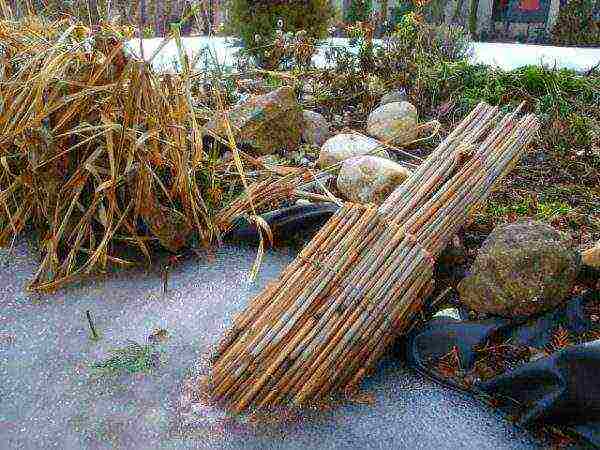 Reeds will prevent thick ice from freezing and give fish oxygen
Reeds will prevent thick ice from freezing and give fish oxygen
- If the container is located indoors or in a greenhouse, then for the winter, feeding carp should be reduced, make feeding depending on the activity of the fish
Business payback for beginners
Breeding carp is not only an opportunity to always have fresh, self-raised fish, but also quite a profitable business. Let's try to calculate its approximate profitability
Costs
- Pool from polypropylene with a volume of 2.7 m3 - 26,000 rubles.
- Malek –3000 rubles. (500 pieces) for the whole container
 Malek carp
Malek carp
- Feed - purchased compound feed at a consumption of 1 bag per month and the duration of feeding, excluding autumn and winter from May to September (5 months), the cost of purchasing it at the cost of one bag weighing 40 kg at 640 rubles. in two years will amount to 6400 rubles.
The total amount of all expenses is 35,400 rubles.
Profit
- Taking into account the population density of a container of this size with at least 200 one-year-old fry per 1 m3 and the percentage of their death in the first year with normal feeding no more than 5% in the second year in the pool you can grow about 500 carps weighing about 1 kg - 500 kg of fish
- Carp marketable weight of 1 kg has an average cost of about 130 rubles - the sale of all farmed fish will bring 65,000 rubles.
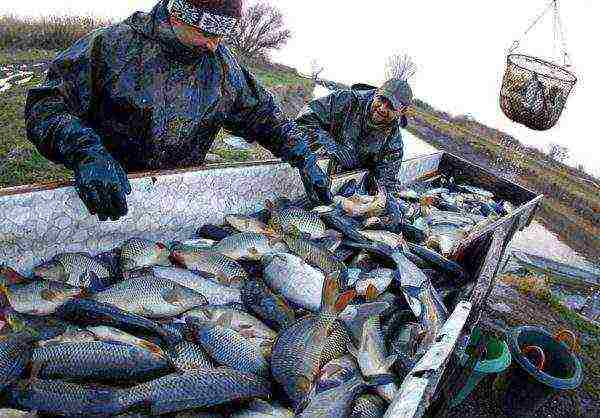 Carp is usually caught in autumn
Carp is usually caught in autumn
- Less all expenses equal to 35 400 rubles. profit is 29,600 rubles., and the estimated profitability of growing carp at home is:
Profitability = (Profit / Cost) × 100 = (29,600 / 35,400) × 100 = 83.6%
Growing carp in a backyard can be not only a good hobby, but also quite a profitable business even for a novice fish breeder.
 Many experts say that among the advantages of carp breeding are the survival of fish to the reservoir, undemanding nutrition and accelerated growth. Therefore, if there is an artificial reservoir or pool at the summer cottage, you must definitely take advantage of this. But for carp breeding at home, you should know some pitfalls and tricks in order to be able to get the desired result.
Many experts say that among the advantages of carp breeding are the survival of fish to the reservoir, undemanding nutrition and accelerated growth. Therefore, if there is an artificial reservoir or pool at the summer cottage, you must definitely take advantage of this. But for carp breeding at home, you should know some pitfalls and tricks in order to be able to get the desired result.
Characteristics and description of carps
This type of freshwater fish widespread and belongs to the genus carp. Its original homeland is Asia, but nowadays this fish is known almost all over the world. Carp has become famous due to the fact that it is quite in demand in the industrial field and it is profitable to breed it.
It is interesting! History knows such a case when English and German fishermen caught carp weighing 38-40 kg on a rod. But the Guinness Book presents a record holder who was caught weighing 41 kg and about 17 years old.
Domestic individuals, unlike wild carps, grow faster and easily take root in the territories of Russia and Ukraine. The most popular breeds in the field of aquaculture are the frame and scaly Ukrainian carp. But for fish farmers from ancient times mirror carp are prized for breeding. Their length is 100 cm, the weight of adult specimens ranges from 35 to 120 kg. This type of fish can be caught only in the Asian open spaces, and in the CIS countries their weight does not exceed 50 kg.
It is interesting! Life expectancy is 50 years. They can lay about 800 eggs if the water temperature is not lower than 17 degrees.
Acquisition of fry
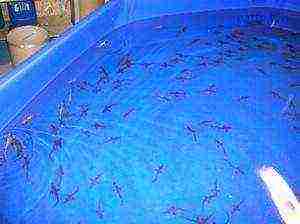 For carp breeding at home, it is advisable to buy fry from fish farms. To do this, you should find out all the necessary information about the farm, about how it has proven itself in the market and how long ago this organization was created. When buying fry, you need to require a license, inquire about the presence of diseases and possible epidemics that have recently occurred.
For carp breeding at home, it is advisable to buy fry from fish farms. To do this, you should find out all the necessary information about the farm, about how it has proven itself in the market and how long ago this organization was created. When buying fry, you need to require a license, inquire about the presence of diseases and possible epidemics that have recently occurred.
All these factors influence the success of the future business., because before purchasing, such nuances affect adaptation to a new place of residence, so you also need to look at the conditions for keeping fish. Most aspiring fish business entrepreneurs believe that if you buy unfertilized caviar and make a Weiss adaptation at home, you can easily raise the young on your own.
This method of growing is quite effective, but there is one drawback - using this device is not so, it just seems at first glance, this requires experience and special knowledge, otherwise a high-quality underyearling will not work for wintering. If such a decision has been made, then you should prepare for the re-purchase of fry from the fish farm, which, in turn, will take time.
Important advice! Long-term fish farmers recommend purchasing underyearlings aged at least 1 year, which have encountered wintering.
Breeding carp at home
Before breeding carp at home, you need to properly equip the pool or pond. It is necessary to create comfortable conditions for fish.
Breeding carp in the pool
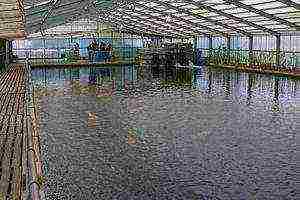 This option assumes a depth of at least 100 cm and a volume of at least 15 cubic meters. Carp - fish takes root in different conditions, therefore, plastic, concrete, ceramics and wood can be used for the pool, forms can also be used of various types. The fish pool should be equipped with a special compressor, filters, drain system, aerators and sterilizers.
This option assumes a depth of at least 100 cm and a volume of at least 15 cubic meters. Carp - fish takes root in different conditions, therefore, plastic, concrete, ceramics and wood can be used for the pool, forms can also be used of various types. The fish pool should be equipped with a special compressor, filters, drain system, aerators and sterilizers.
But despite the laborious chores, most fish farmers prefer to raise carp in the pool. In this case, it is possible to regulate the temperature and water circulation, and this significantly affects the life of the fish. The pool is effective in that it is easy to set the desired oxygen level in it.
Silo basins appeared not so long ago and have already begun to gain popularity. The design principle is as follows: water is supplied from below and, overflowing around the circumference, fills the container to the desired level. There is also a drawback, the size of this pool is quite small, which is very disadvantageous. Carp should be launched into the pool when microflora has formed. As the fish grows, it is recommended to periodically drain and refill with new water.
Need to know! April and March are the best times to start fry.
Breeding burls in a pond
 If the country house already has an old reservoir, it is enough to clean it and provide the pond with plant food. But such reservoirs are not always available, in this case, for carp breeding, it should be created artificially. Preparation will not take more than 1 year... The parameters of the pond according to the technology are as follows: the depth is on average 150 cm, and the area is not less than 300 * 300 cm. Trees and grass are necessarily planted near the shore - this will ensure the consolidation of the edges of the reservoir. At the end, special algae and the rest of the vegetation are planted for food.
If the country house already has an old reservoir, it is enough to clean it and provide the pond with plant food. But such reservoirs are not always available, in this case, for carp breeding, it should be created artificially. Preparation will not take more than 1 year... The parameters of the pond according to the technology are as follows: the depth is on average 150 cm, and the area is not less than 300 * 300 cm. Trees and grass are necessarily planted near the shore - this will ensure the consolidation of the edges of the reservoir. At the end, special algae and the rest of the vegetation are planted for food.
Some fish farmers advise to compact the bottom, and this is done with concrete and sand. A rubber film is laid on top of the frozen solution, then water is poured and zooplankton is bred, and then the artificial nature of the reservoir is created. Carps prefer warm water, so filling with cold water is strongly discouraged.
After the whole process, the water in the pond should be infused up to a temperature of 25 degrees on average.To make microflora in an accelerated mode, it is enough to take a couple of dozen buckets of water from a wild reservoir and add it to an artificial pond. It is not advisable to build a container in the lowlands, as well as near roads.
Need to know! Do not allow waterfowl to settle on the pond, they can infect.
Feeding carp
After 9 months of carp breeding, an individual of 500 grams can grow from small caviar if the fish is given a complete and balanced diet. For fry, such animals are suitable as food: molluscs, insect larvae, ciliates, worms and small crustaceans. According to the technology, carp are bred in a semi-intensive and intensive way:
 Semi-intensive method... This method uses agricultural and zoological feed, for example: oats, corn and wheat. 1500 kg of fish are obtained per unit area. In the summer season, a large amount of protein will be required, for these purposes compound feed is suitable, because this is what experts advise.
Semi-intensive method... This method uses agricultural and zoological feed, for example: oats, corn and wheat. 1500 kg of fish are obtained per unit area. In the summer season, a large amount of protein will be required, for these purposes compound feed is suitable, because this is what experts advise.- Intensive method... Carps feed mainly on vegetation and zooplankton. This method has the advantages of not requiring high expenditures for feeding, but there is also a disadvantage, per unit area there is an average of 450 kg of fish. But food mainly consists of compound feed with a protein content of 40%. If, with this method, a reservoir is organized over a large area, then there will be a risk of an epidemic that can kill all the fish.
It is not recommended to feed fish with a large surplus, the leftover feed will only pollute the water. One individual accounts for food for 3% of the weight of the fish itself... Meals are provided 2 times a day.
Carp behavior in winter
During the winter season, carps eat less and hibernate. If the artificial reservoir is small in size, then the carp may die; it winters well in natural ponds. The problem is the lack of oxygen in the water.
The problem can be solved! It is enough to purchase the equipment. It is necessary to install an aeration device in the reservoir, which will maintain the temperature within 0 degrees. There is also a second option, carp should be moved to a huge room container.
After the first snow melt, it is allowed to move the fish back into the reservoir, but on the condition that the water in it has warmed up sufficiently.
It's important to know! Carps throw fish in shallow water for several days, then they begin to feed intensively, gaining strength. Fish at the age of three can get rubella, the disease should be prevented in a timely manner. For high profits, it is recommended to buy a set of equipment:
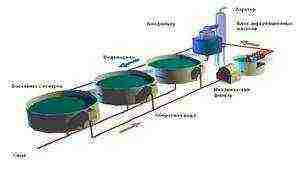 pump;
pump;- cage nets;
- barrels;
- incubator for growing caviar;
- filters for cleaning;
- reed mower;
- measuring device;
- sterilizers for ultrafiltration, as well as ozonizers;
- oxygen generator;
- closed type water supply with a return outlet;
- auto feeder;
- backlight.
This equipment will significantly simplify the task and bring high profits to the fish farmer..
> 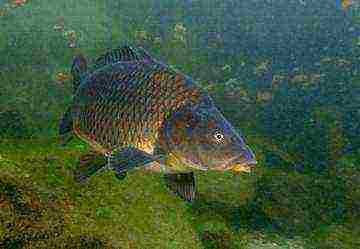
Carp is practically an omnivorous fish and very unpretentious, it feels itself perfectly in small rivers, reservoirs without a current. Favorite habitats for carp are lakes and ponds, where the sun's rays penetrate well, and have a bottom with silt. This fish is hardy, carp can safely stay in low temperature water, as well as in water where there is very little oxygen. In winter, carp hibernate under the ice. Thanks to the unpretentiousness of the carp, people have learned to breed it in artificial conditions. But one should not think that this is a very simple process, it must be approached seriously and with all care.
Breeding features
Undoubtedly, a reservoir will be required for domestic fish farming. You also need to take into account certain conditions that will be important for carp. These include:
- Quality water supply
- Oxygenation of water
- Compliance with proper nutrition.
For a detailed consideration of the conditions, it is necessary to determine what kind of reservoir will be.
Carp can be bred in a wide variety of water bodies. Small lakes, ponds, pools are suitable for these purposes. The bottom is equipped with clay or film, concrete or brick would be ideal. This stage of arrangement is very important, however, special attention is paid to water supply when breeding carp.
The amount of water, as well as its quality, depends on what the water supply of the pond will be. According to technological standards, the reservoir should be flowing, but the current should not be made strong.
Pay attention to the filtration system, which is of great importance for reservoirs with a weak flow. The most suitable would be a two-stage filtration, which includes biological and mechanical treatment. Such a system will help to cleanse organic waste and food debris from the pond, and will also ensure the gas balance at an optimal level. Otherwise, you may encounter the problem of pond pollution (see details here).
Features of breeding in a pond
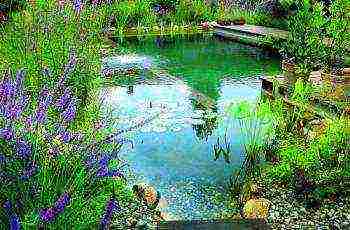
- For fruitful fish farming, the depth of the pond should be at least one and a half meters, but not more than two. If you make the pond too deep, the water will not be able to warm up well, and the carp loves warmth. The total volume of the reservoir should be at least 8 tons, which means that its size will be approximately 3 by 3 meters. For arranging an artificial reservoir, you can use a rubber film for a pond.
- It is best to place the pond in a quiet corner of the summer cottage; in a busy place, the fish can be frightened by noise from the road or work process. A prerequisite is good lighting and exposure to the sun's rays, but some can be left in the shade.
- The optimum water temperature should be 24-26 degrees Celsius. With a decrease in temperature, the intensity of fish feeding will also decrease. The fish will even completely refuse food if the maximum temperature is -4 degrees, for +30 degrees. These temperatures are unfavorable for carp.
- The reservoir, as a rule, is not placed in a lowland, otherwise dirty runoff water or melt water can get into the pond during rain and melting snow. The construction of a pond does not differ from the process of constructing a decorative reservoir. The dug pond is filled with water, and the stocking is carried out only after the water has settled. The best period for stocking fish is March - April.
- To successfully breed fish at home, it is necessary to plant various plants on the walls of the pond, the vegetation will serve as the basis for gluing the eggs.
Features of breeding in pools
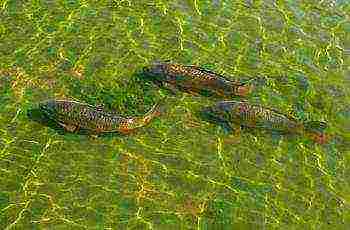
Breeding fish is more profitable and convenient in swimming pools. This is due to the fact that in such reservoirs it is much easier to maintain the desired temperature, as well as to regulate the frequency of water exchange. They are easier to clean and much easier to maintain optimal oxygen conditions.
Most often, pools are made of fiberglass, they have the most suitable parameters. Such a pool can be chosen in any shape: square, rectangular, round, or any shape. The size of an artificial reservoir can vary from 1 to 40 cubic meters. Read more about deep summer cottage pools here.
More and more often you can find vertical pools - silos. Their peculiarity is that water is supplied from the bottom and flows down through the top. The silos are small, but you can get good carp offspring in them.
The prepared pool is filled with water, then it is defended for several days, and microorganisms are allowed to appear. A small amount of grass is thrown into the water, several buckets of water from a natural reservoir are poured.
It is imperative to saturate the water with oxygen in the pool, drain it, pump it up. A process such as aeration can be done with any processor.
Carp breeding technology
Successful breeding of carp at home will be impossible if you do not select a suitable breed. It's all about the climatic conditions that vary from region to region in our country.
The most optimal option will be the varieties that live in the region of residence.
For example, in Eastern and Western Siberia, it is best to breed Sarboyan and Altai carp. In the northern and central regions, the Central Russian, Parish and Chuvash carp will feel great. In the southern regions, it is best to breed Krasnodar and Stavropol carp. However, mirror carp are most often bred, since there are practically no scales on it. Breeding conditions are the same as for other species.
Where to get carp fry
The easiest and most affordable way to start raising fish in your pond in your country house or in your garden is to catch fry in the fall, and in the spring to populate them in a pond. If there is no opportunity to purchase one-year-old carp, the reservoir is filled with fry using the method of growing juveniles (growing fry from larvae in special nursery ponds). If it is rather difficult to buy planting material, it is necessary to have several types of ponds, which will be intended for wintering, breeding and growing carp. If you leave carp in the pond for the winter, it is important to take care of its aeration. Read more about this here.
The easiest way is to buy farmed carp fry from a fish farm or specialty store. It is good if there is such a farm in your region. If not, then you can place an order in another area, subject to the possibility of transportation.
On the video - in detail about fry, carp breeding and conditions of their keeping:
How to breed
Female carp are quite fertile, so a few females and males will be enough for reproduction. For spawning in vivo, the ratio of females to males will be 1 to 2, when fertilizing eggs at home, the ratio will be 1 to 1.
It is not an easy task to establish the sex of this fish, in specimens that have not reached sexual maturity, this task cannot at all be feasible. It is possible to distinguish males from females only during the spawning period.
At this time, a special outfit (mating) appears on the head of males, as well as on the lids near the gills, which is manifested by rather tough warts, the genital opening begins to take the form of a slit. If you press on the abdomen, the males will release milk. In females, the abdomen increases, it is soft to the touch, and the genital opening acquires a red tint, slightly swells.
During the spawning period, it is necessary to maintain the water temperature, it should be 17-18 degrees. The bottom of the pond, as well as its sides, should be covered with soft vegetation, since the female will lay eggs on the substrate. Eggs will develop within 3-6 days. At first, embryos are inactive, feeding on substances that are contained in their yolk sac. Over time, small fish will begin to feed more intensively, consuming algae, small crustaceans and rotifers.
How to grow
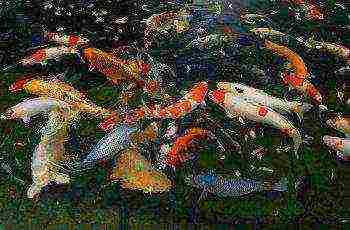
We talked about the temperature, reservoirs, reproduction, but one cannot ignore such a process as feeding carp, because without it, cultivation is also impossible.
- Carp should be fed twice a day. There should be a specially designated place for feeding.
- You do not need to give a large amount of food at one time, not eaten immediately, it will only pollute the pond, it will rot, which will affect the composition and quality of water in the reservoir. Carp have enough feed at the rate of 3% of their own weight. There is no need to throw food directly into the pond, it is best to feed from the tray by lowering it into the water.
- Carp is unpretentious and eats almost everything. In addition to special feed for fish, compound feed intended for chickens and pigs is also suitable. Such food must first be kneaded to a dough state.He loves fish and earthworms, various larvae, even uses legumes, for example, beans and peas.
Here is such an amazing carp fish, which you can grow at home.
How to breed carp? Today this interesting question will become a new article on our site.
We decided to understand all the ins and outs of breeding and keeping this fish both at home and in the pond.
The situation on the fish market is such that it is worth seriously thinking about organizing this business at home and with competent and timely actions. home carp farming business idea can become very successful.
We tried to put together all the pros and cons of breeding. I hope the information below will be useful to you and will answer all your questions.
Carp farming business
Carp is a very tenacious and essentially unpretentious fish. Below you will be convinced that breeding carp, even in the country, is not a difficult task, which can be implemented in just a few days.
In addition, the requests of this fish are not only striking in their minimal content, but also make you simply become a fan of carp.
So why did so many people go to the question of carp breeding with such persistence? ... Let me write down the main points.
The meaning of carp breeding or who needs it
As I said above, the market situation is such that it pushes people to grow fish even at their dacha. So why is this happening.
Here are the main reasons for breeding carp:
- The request is not great... This fish has become the object of our attention for a reason. The fact is that, in comparison even with the breeding of unpretentious aquarium fish, our hero is distinguished by truly tenacious characters. I will tell you about the care and maintenance of carp below.
- Carp price... Unfortunately, the situation is such that a kilogram of carp at the moment can reach from 200-400 rubles and this figure is only increasing every year. Therefore, there are more and more people who want to start breeding carp in the pond every day.
As you hopefully have noticed, this business has a number of advantages that put this business at a decent level in terms of prospects for development and increasing the volume of profit.
Therefore, let's talk about the idea of growing carp at home in more detail.
How to start a carp farming business
Before you start breeding carp, you need to make at least rough calculations in the business plan.
In order to breed carp, it is necessary to take into account a number of features without which your fish cannot coexist:
Water temperature for carp breeding
Carp, although it is considered an unpretentious fish, still requires a certain range of water temperatures for normal existence.
For this kind of fish, the critical temperature will be +30 C. The fact is that such a temperature lowers the percentage of oxygen in the water and your pets may suffocate from this.
Unfortunately, when breeding carp in a pond, the death of one fish can lead to the death of the rest due to the rotting of the first.
Actually, because of the temperature, carp for the most part live the lion's share of life at depth, in muddy pits, and are looking for food in the same place.
There were cases when a carp accidentally caught in a puddle quietly coexisted in it until the water completely dried out.
This fish can live in extremely extreme conditions, even in the presence of wet soil, as in the case of a puddle.
Features of feeding carp
To the question of how to breed carp, we would like to tell you, first of all, about feeding this fish.
If you breed carp at home, there is one important thing to keep in mind. You should do complementary foods in one place.
This method is taken from fishermen and allows you to influence the movement of fish.
In this way, you will always know where to catch adults.They will come to this place during the feeding hours.
This is often morning and evening. In terms of diet, we can say that carp is omnivorous and many people compare it to pigs.
This comparison came not in appearance, but rather in the way of food. Just like a pig, carp eats whatever is given to it, the main thing is that this content does not contain various chemical additives.
And so you may well throw him plant food or, in the end, when breeding carp in the country - dig worms.
Here is a list of the main stages in carp breeding both at home, for example, in the country, and in the pond, with mass breeding:
Preparing a carp breeding site
You must choose a place where it will be convenient to organize a reservoir. It doesn't matter whether it is big or not.
The main thing is the quality of the soil and its professional suitability for the organization of the reservoir.
One of my good acquaintances decided to organize a pond in his country: he hired an excavator, chose a place and got down to work. By the way, the place was really good. There were earthen ramparts all around and a small stream flowed in the center. In fact, it was only necessary to build a normal dam at the end and that's it. However, the ground was heavily dug up by moles and the water was constantly flowing through the wormholes. There were cases when in the morning there was a full body of water, and in the evening a small puddle remained from it. Thus, the venture failed miserably.
We build a reservoir and fill it with water
If you are completely and completely sure that the soil will allow you to make a reservoir, then you should turn your eyes to construction.
When raising carp at home, you must use common sense and understand that you need a constant source of water for proper breeding.
If this is not the case, then you cannot create a normal pond a priori. Therefore, it is necessary to take into account a number of factors from the ground to a permanent source of water.
After all, if the water is stagnant and does not at least partially renew, then soon it will turn green and the fish will definitely not like this state of affairs.
In addition, we note that after filling your reservoir, you should not start the fish right away.
It is necessary to wait a few hours, or preferably a day, so that the water warms up and is not a cold shower for carp.
As you can see, carp breeding both at home and when breeding in a pond requires not small conditions, first of all, in the organization of the reservoir and its constant maintenance.
Features of carp breeding
Spawning carp in your pond is the first call to the fact that everything is done correctly.
It should be borne in mind that in small reservoirs, with a large number of fish, spawning can continue until late summer. It's all about the small area of the reservoir.
There is no need to fuss about this, but still a spacious reservoir will create more conditions and advantages for you to breed carp.
Therefore, the increase in the area of the reservoir should be in the forefront when looking at the future of your business.
Actually, carp are taken for sale after spawning. I advise you not to select the largest individuals, but to find medium-sized fish.
The fact is that, like many fish, carp loses its taste characteristics with age and should be left for breeding.
I hope we answered the question of how to breed carp and proved to you the prospects of this business. You can look at other ideas for starting your own business on our website of business ideas and plans, also do not forget to subscribe to our group of new business ideas and plans in order to keep abreast of the latest developments in business.

